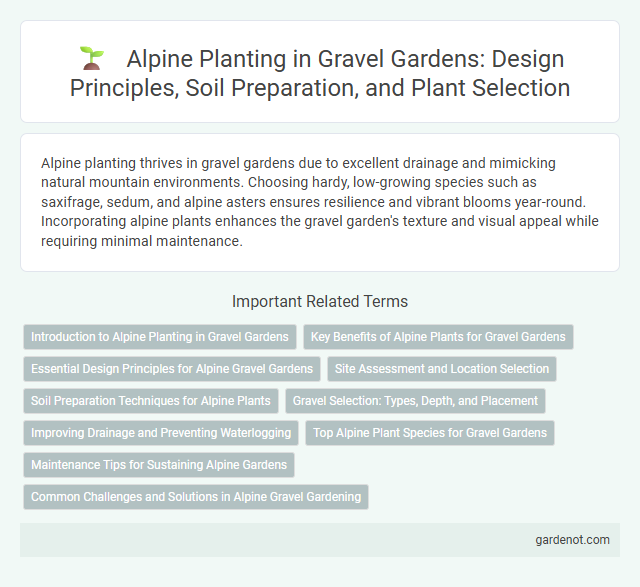Alpine planting thrives in gravel gardens due to excellent drainage and mimicking natural mountain environments. Choosing hardy, low-growing species such as saxifrage, sedum, and alpine asters ensures resilience and vibrant blooms year-round. Incorporating alpine plants enhances the gravel garden's texture and visual appeal while requiring minimal maintenance.
Introduction to Alpine Planting in Gravel Gardens
Alpine planting in gravel gardens showcases hardy, low-maintenance plants adapted to rocky, well-drained soils typical of mountainous regions. These plants, including saxifrages, sedums, and dwarf conifers, thrive in nutrient-poor substrates and require minimal water, making them ideal for sustainable gardening. Incorporating alpine species enhances biodiversity and adds textured greenery and vibrant blooms to gravel gardens, creating a naturalistic and resilient landscape.
Key Benefits of Alpine Plants for Gravel Gardens
Alpine plants offer drought tolerance and low maintenance, making them ideal for gravel gardens with well-drained soil. Their compact growth and vibrant blooms enhance the aesthetic appeal while conserving water resources. Additionally, alpine plants support local biodiversity by attracting pollinators to gravel garden ecosystems.
Essential Design Principles for Alpine Gravel Gardens
Alpine planting in gravel gardens requires well-drained, gritty soil to mimic mountain environments, ensuring optimal root health and moisture control. Selecting compact, drought-tolerant alpine species such as saxifrage, sedum, and alpine phlox enhances resilience and visual appeal. Strategic placement of rocks and gravel provides essential microclimates and natural drainage, promoting sustainable growth and year-round interest.
Site Assessment and Location Selection
Site assessment for alpine planting in a gravel garden involves analyzing soil drainage, sunlight exposure, and microclimate conditions to ensure optimal growth. Selecting a location with well-drained, rocky or sandy soil mimics natural alpine environments, providing roots with minimal water retention and preventing rot. Elevation and slope orientation should favor full sun or partial shade, promoting robust development of drought-tolerant alpine species.
Soil Preparation Techniques for Alpine Plants
Alpine planting thrives in well-drained, gritty soil rich in minerals, mimicking natural mountain environments. Soil preparation involves incorporating sharp sand, fine gravel, and organic matter such as composted leaf mold to improve drainage and nutrient availability. Maintaining a slightly alkaline pH and avoiding heavy clay ensures optimal root development and healthy alpine growth in gravel gardens.
Gravel Selection: Types, Depth, and Placement
Selecting the right gravel for alpine planting involves choosing angular, well-draining gravel types such as crushed granite or limestone that mimic natural mountain environments. The gravel layer should be at least 2 to 3 inches deep to ensure proper drainage and prevent waterlogging, which is crucial for the health of alpine plants. Placement of gravel around plants not only stabilizes roots but also minimizes weed growth and retains soil moisture, enhancing plant vigor in the gravel garden setting.
Improving Drainage and Preventing Waterlogging
Alpine planting thrives in gravel gardens due to their excellent drainage properties, which prevent waterlogging and root rot in delicate mountain plants. Incorporating coarse gravel or crushed stone improves soil aeration and facilitates rapid water runoff, essential for species such as saxifrages and sedums. Properly graded slopes and raised beds enhance water dispersal, creating an ideal environment for drought-tolerant alpine flora.
Top Alpine Plant Species for Gravel Gardens
Top alpine plant species for gravel gardens include Saxifraga oppositifolia, which thrives in well-drained, rocky soils and produces vibrant purple flowers in early spring. Sedum species, such as Sedum acre and Sedum spurium, offer drought tolerance and attractive fleshy foliage that complements gravel settings. Draba aizoides, known for its bright yellow blooms and mat-forming habit, enhances texture and color in alpine gravel garden designs.
Maintenance Tips for Sustaining Alpine Gardens
Alpine planting in gravel gardens thrives with well-drained soil and minimal water, preventing root rot and encouraging healthy growth. Regular removal of dead foliage and careful weeding ensures nutrient availability and reduces competition for moisture in these nutrient-poor conditions. Seasonal pruning and mulching with gravel or small stones help maintain soil temperature and moisture balance, sustaining the alpine garden's unique ecosystem.
Common Challenges and Solutions in Alpine Gravel Gardening
Alpine gravel gardening presents challenges such as poor drainage, extreme temperature fluctuations, and limited nutrient availability. Solutions include using well-draining, gritty substrates to prevent root rot, selecting drought-tolerant alpine species adapted to harsh conditions, and incorporating slow-release fertilizers to sustain nutrient levels. Proper site selection with full sun exposure and shelter from strong winds also enhances plant resilience and growth in alpine gravel environments.
Alpine planting Infographic

 gardenot.com
gardenot.com